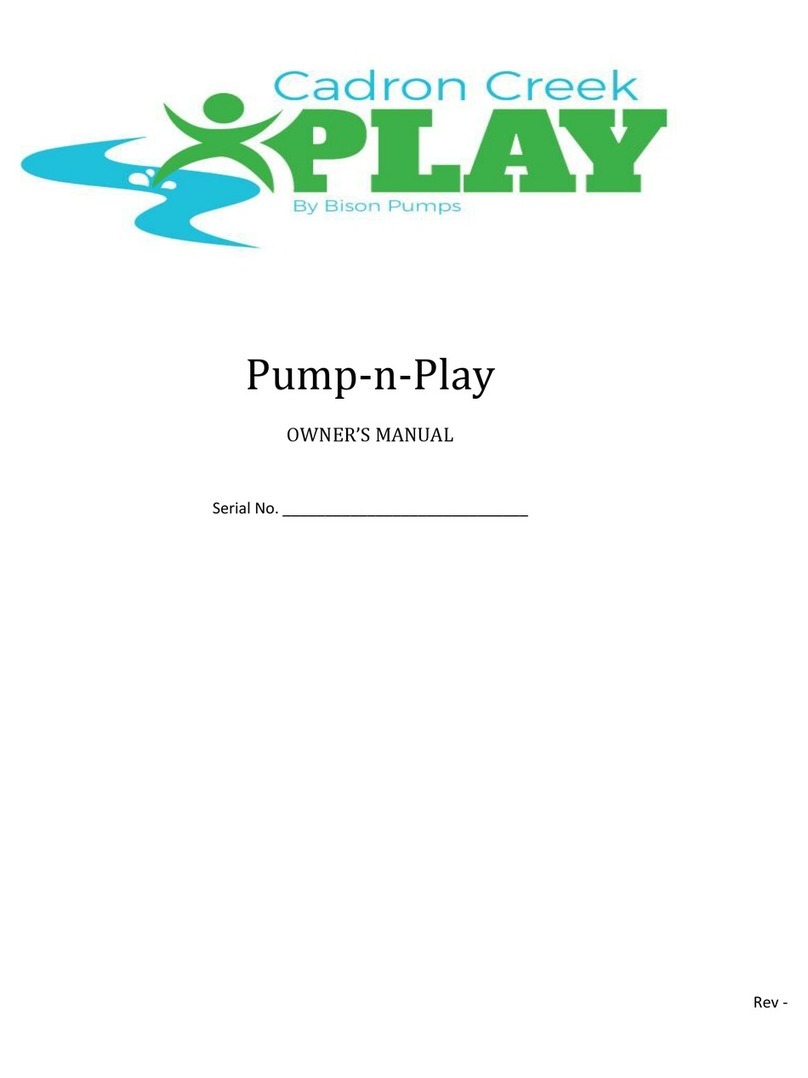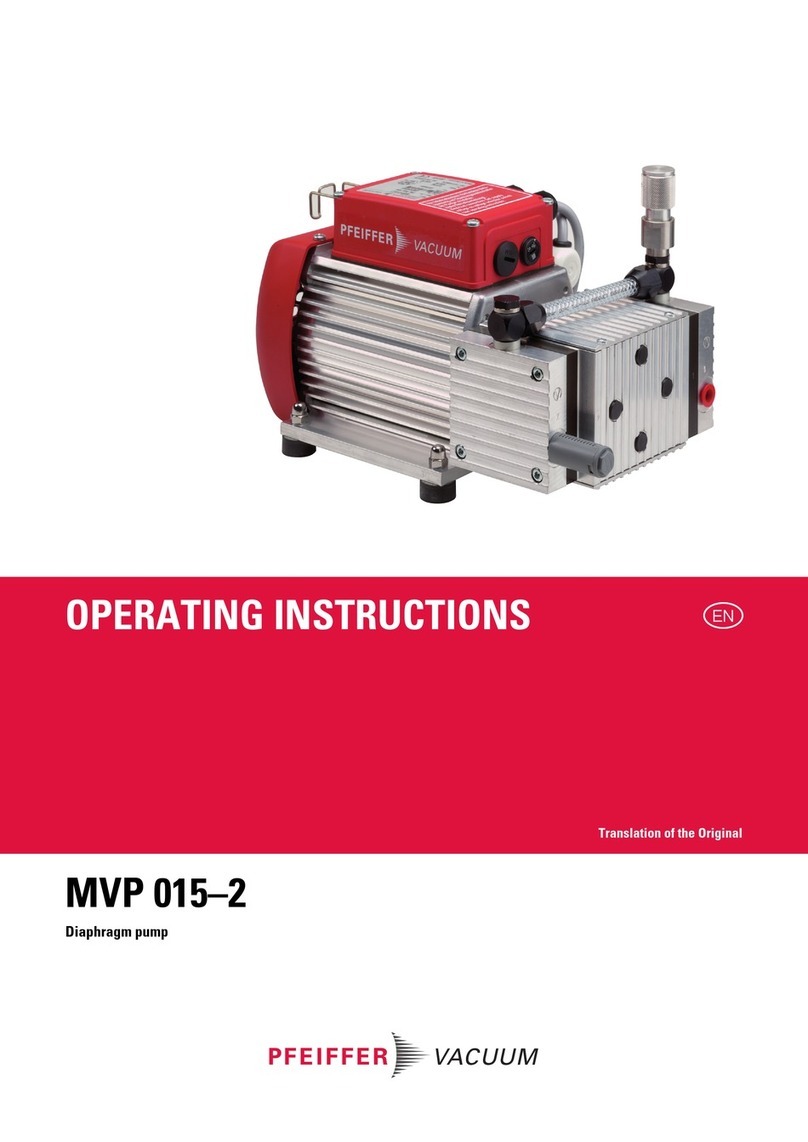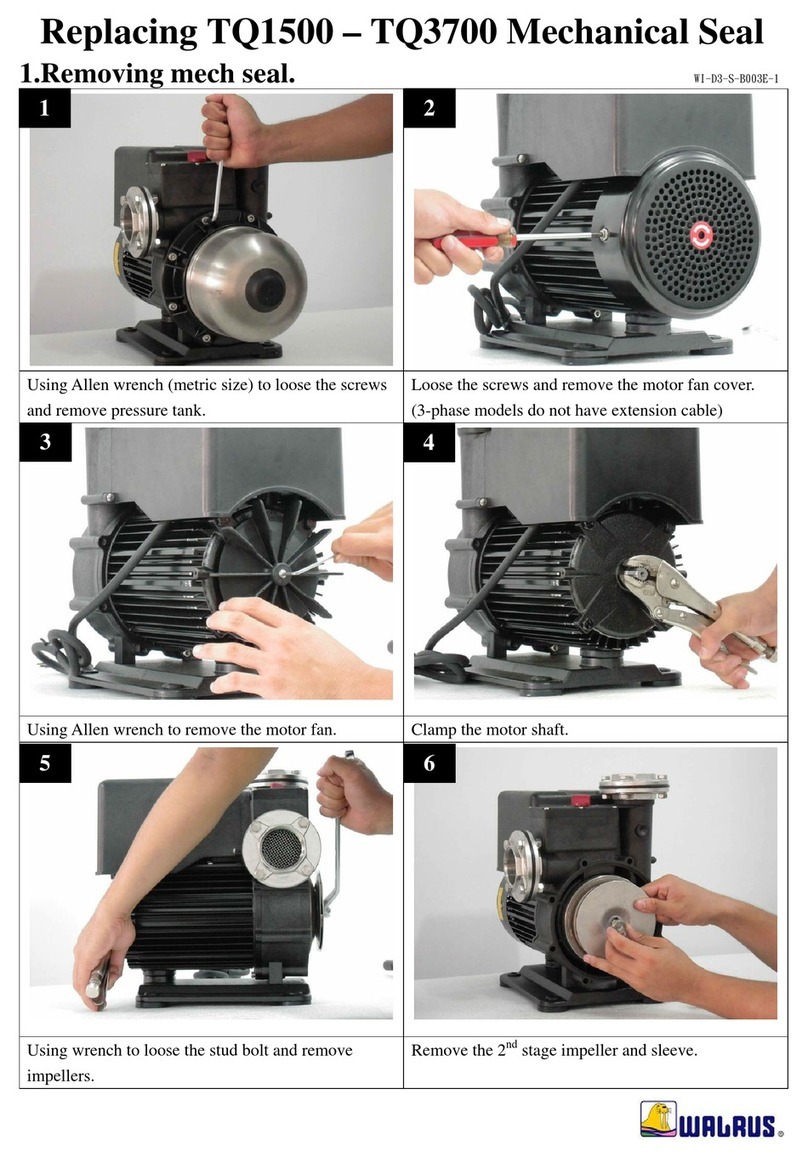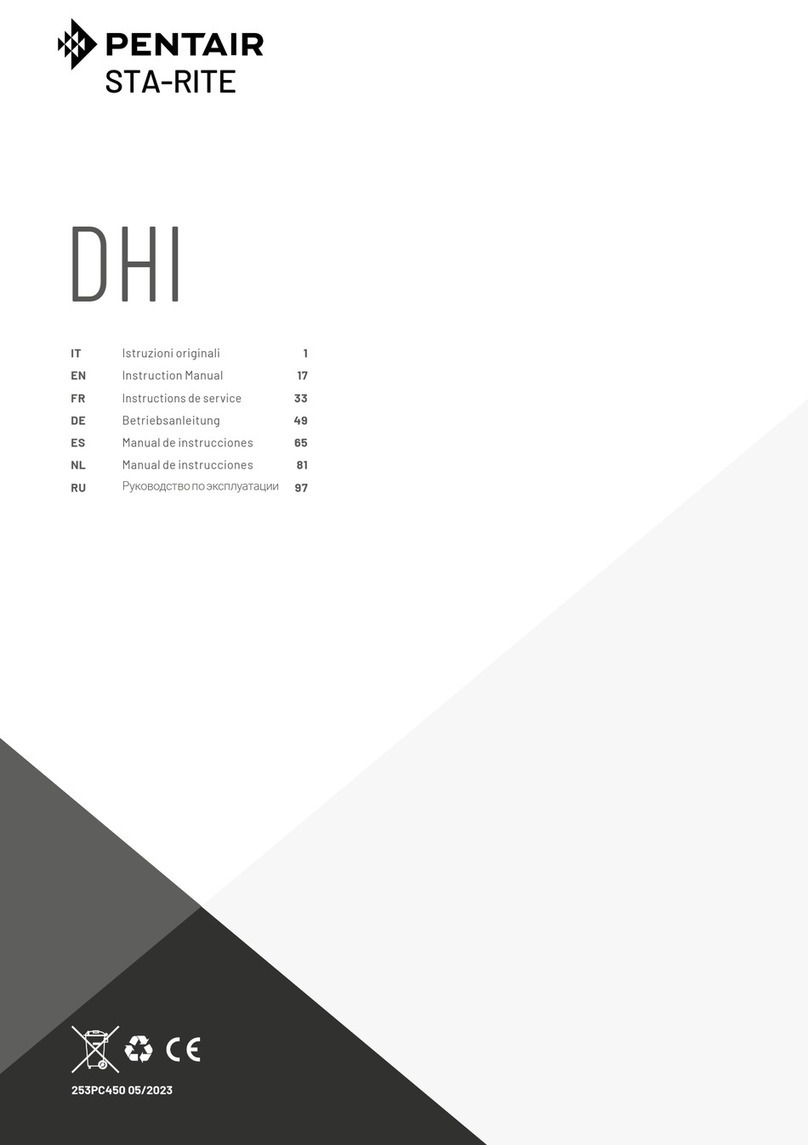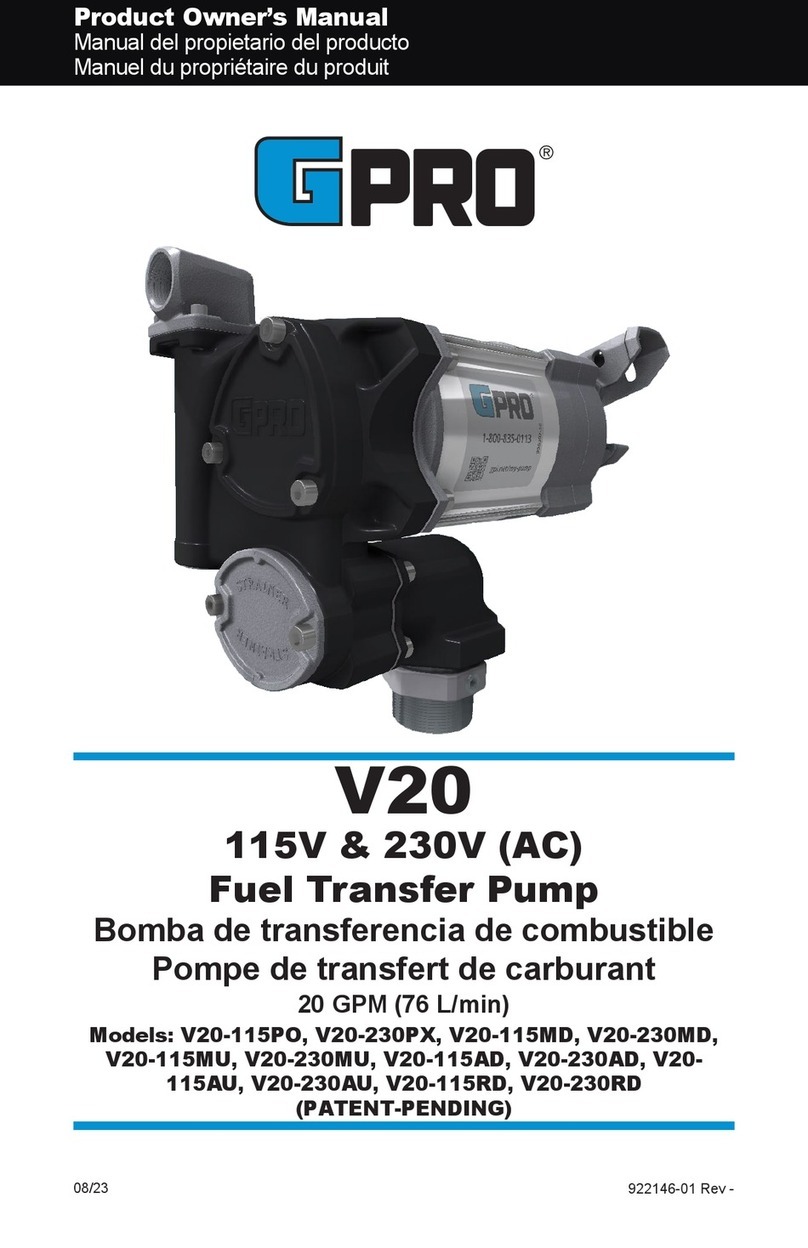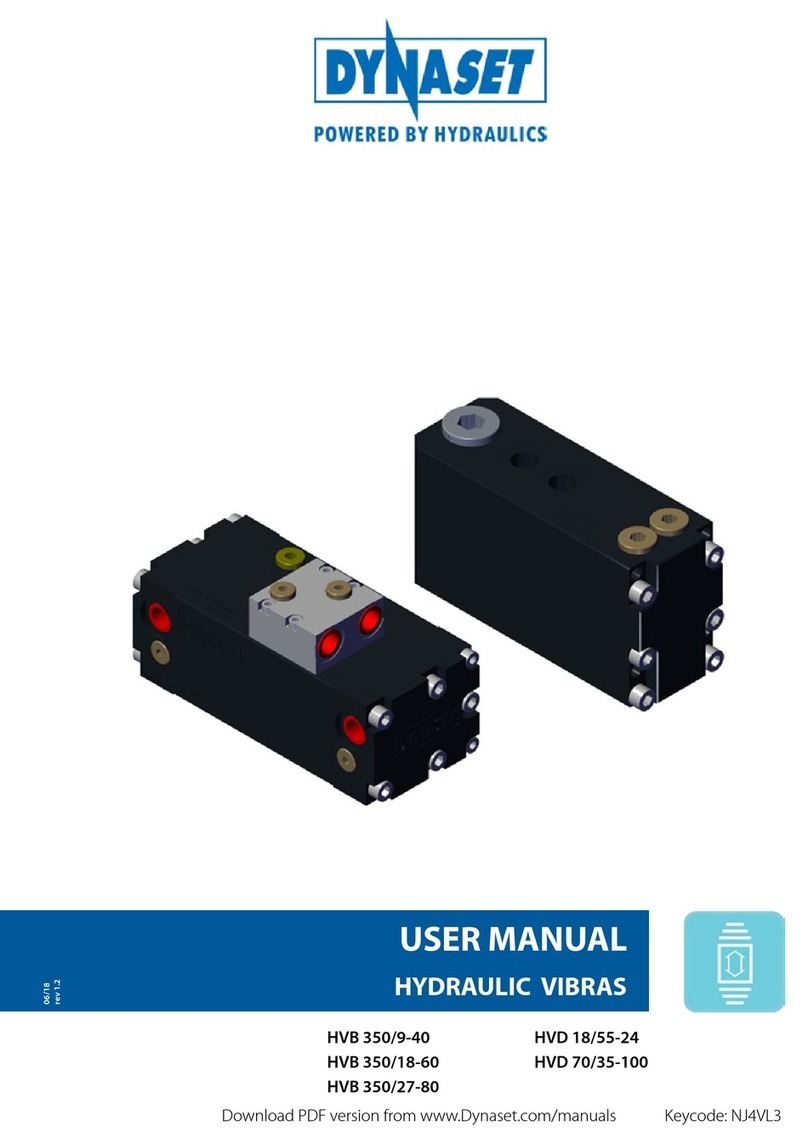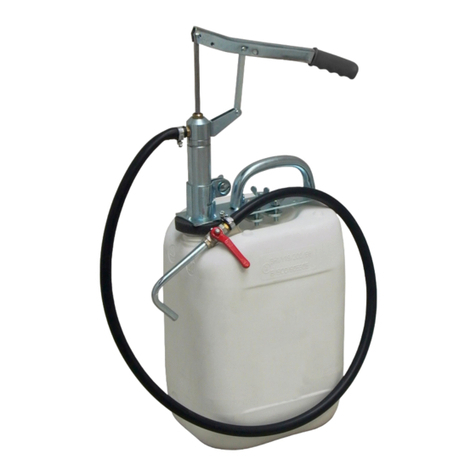Bison Pumps 1900 Operating and maintenance instructions

Rev B-6
Model 1900 Maintenance Instructions
Rod Connector Secured
with a Shoulder Screw
with Drain Back Feature
For Pump Revision: B
Bison Pumps
www.bisonpumps.com
Model 1900 Maintenance Manual Rev B-6
1 of 16

1
Table of Contents
Maintenance Instructions
1. Handle Disassembly ...................................................................................................................................... 5
2. Top Plate/Rod Assembly removal from Cylinder Body and separation........................................................ 5
3. Top Plate Disassembly................................................................................................................................... 6
4. Rod/Piston Cup Disassembly......................................................................................................................... 6
5. Drain Pin Assembly Removal......................................................................................................................... 7
6. Lower Check Valve Disassembly ................................................................................................................... 7
7. Bottom Plate Reassembly ............................................................................................................................. 8
8. Drain Pin Installation..................................................................................................................................... 9
9. Pump Body Installation...............................................................................................................................10
10. Rod/Piston Cup Assembly...........................................................................................................................10
11. Top Plate/Lift Rod Assembly.......................................................................................................................11
12. Handle Reassembly.....................................................................................................................................12
13. Mechanical Assembly Installation onto Pump Body...................................................................................12
14. Test the Pump.............................................................................................................................................12
Appendix
Detail A: Exploded View .............................................................................................................................14
Detail B: Part Listing ...................................................................................................................................15
Caution: Failure to carefully follow procedures may result in property damage and serious injury.
Caution: The following personal protective equipment is recommended during all maintenance operations:
-Safety Glasses
Bison Pumps
www.bisonpumps.com
Model 1900 Maintenance Manual Rev B-6
2 of 16

2
Recommended Tool List:
1. Two (2) 9/16” Box Wrenches
2. One (1) 5/32” Allen Wrench
3. One (1) Flathead Screwdriver with small tip (1/4”)
4. One (1) 3/16” Allen Wrench
5. One (1) ½” Box Wrench
6. One (1) Bench Vice
7. One (1) 1/8” Allen Wrench
8. One (1) 16 oz. Hammer
9. One (1) 5/32” Drift Punch
10. 12”x12” Clean Cotton Rag
11. One (1) Pair of Safety Goggles or Glasses
12. One (1) Internal Snap Ring Pliers, .070”-.078” Tip –Available for Purchase
13. One (1) Can Extra Virgin Olive Oil
14. One (1) O-Ring Pick Tool –Included in Kit
15. One (1) Adjustable Pipe Wrench (18”)
16. One (1) Roll Teflon Tape –Available for Purchase
17. One (1) Special Drain Back Retrieval Tool –Available for Purchase
a. ½” Socket with Appropriate Rubber Inside
b. 12” Extension
c. Combination Ratchet
18. One (1) Long Screwdriver or Dowel (16”)
*Closest matching Metric sizes may also be used*
Bison Pumps
www.bisonpumps.com
Model 1900 Maintenance Manual Rev B-6
3 of 16

3
Contents of Maintenance Kit:
55-001-2-04-01
Part Description Quantity Bison Part Number
Top Plate:
1. Securing Top Plate
a. Custom Low-Profile Internal Hex Fastener 1 50-001-0-08-02
2. Internal Top Plate Components
a. Packing Gland Nut 1 50-100-0-07-00
b. Backing Washer, Nylon 5/8” OD 1 04-000-5-40-02
c. Packing Gland Cup Seal 0.5” ID 1 04-001-3-71-01
d. Bottom Bushing 1 50-100-0-08-05
3. External Top Plate Component
a. O-Ring Buna 1 04-139-3-70-02
Piston Assembly/Pump Body:
4. Securing Rod Connector
a. Shoulder Screw 316 Stainless Steel 1 50-001-0-04-05
5. Check Valve 2 04-000-5-75-01
6. Internal Snap Ring, Stainless Steel 2 04-022-1-68-01
7. Piston Cup Seal 2 04-002-3-71-01
8. O-Ring Buna 0.24” ID 1 04-070-3-70-01
9. O-Ring Buna 0.30” ID 1 04-070-3-70-02
Handle:
10. Link Washer, Nylon 3/8” OD 12 04-000-5-40-01
11. Ny-Loc Nut, Link Connection 2 04-000-1-50-20
12. Ny-Loc Nut, Shoulder Bolt 1 04-000-1-50-19
Tools:
13. O-Ring Pick Tool 1 55-001-0-07-00
See Details A & B for an exploded view and a full part listing of the pump components.
Bison Pumps
www.bisonpumps.com
Model 1900 Maintenance Manual Rev B-6
4 of 16

4
Bison Pumps
www.bisonpumps.com
Model 1900 Maintenance Manual Rev B-6
5 of 16

5
1) Handle Disassembly:
a. Use two 9/16” wrenches to turn the Ny-loc nuts counter-clockwise to
loosen and remove them from the bolts as shown below. Discard the used
Ny-loc nuts as they will be replaced. A 3/16” Allen wrench should be used
in place of one of the 9/16” wrenches if shoulder bolts are
present.
b. Remove the two bolts from the assembly and set aside for reassembly,
along with the Links. Discard the used Link Washers as they will be
replaced.
c. Use a 3/16” Allen wrench and a ½” wrench to loosen and remove the Ny-
loc nut from the shoulder bolt.
d. Remove the bolt from the assembly. Separate the handle from the lift rod
and set aside for later reassembly.
2) Top Plate/Rod Assembly removal from Cylinder Body and separation:
a. Use a 5/32” Allen wrench or flat head screwdriver (1/4” tip) to loosen and
remove the 4 fasteners attaching the top plate to the cylinder body, in a
counter-clockwise direction, as shown in Figure 2. Set aside fasteners for
reinstallation. There is 1 spare screw in the maintenance kit.
b. Carefully lift the top plate and Piston Assembly to separate it from the
Pump Body. This should require minimum force to remove.
c. Remove the shoulder screw from the Rod
Connector using a 1/8” Allen wrench, as
shown in Figure 3.
d. Separate the Rod Connector from the Rod.
e. Separate the Rod from the top plate.
Figure 1
Figure 2
Figure 3
Shoulder Bolt
Link Bolt X2
Bison Pumps
www.bisonpumps.com
Model 1900 Maintenance Manual Rev B-6
6 of 16

6
3) Top Plate Disassembly:
a. Use your hand, loosen and remove the Gland Nut by turning it counter-
clockwise, as shown in Figure 4. Discard the used Gland Nut. There is a
replacement component, located in the maintenance kit.
Note: If you cannot loosen the Gland Nut by hand, use a 1-1/8” open end wrench or a
pair of pliers to lightly apply pressure in the counter-clockwise direction until the Gland
Nut beaks loose. Then run the Gland Nut out by hand and remove.
b. Use the O-ring Pick provided in the maintenance kit to remove
the Packing Gland Cup Seal, Backing Washer and Bottom Bushing, as
shown in Figure 5. Discard all removed components. There is a
replacement for each, located in the maintenance kit.
4) Rod/Piston Cup Disassembly:
a. Fold a 12”x12” Cloth Rag in half and wrap it around the Lift Rod. Use a vice to
secure the Rod in a position that allows access to the snap ring inside the bottom of
the Piston Cup, retaining the check valve, as shown in Figure 6.
Note: Clamp the Rod in the vice with enough force to hold it in position securely, but
not so much as to damage or mar the surface of the Rod.
b. Use the O-ring Pick Tool to remove two Piston Cup Seals from the outer surface
of the piston. Discard both gaskets, they will be replaced using new components from
the maintenance kit.
c. Use the Internal Snap Ring Pliers to remove the
Internal Snap Ring by inserting the tip of the pilers into the
two holes, squeezing them together, and lifting the ring
out of the cavity, as shown in Figure 7. Discard the Snap
Ring, it will be replaced with a new component from the
maintenance kit.
d. Use a Flat Head Screwdriver, push the Check Valve out
of the cavity as shown in Figure 8. Take care not to damage
the wall of the cavity or ring groove. Discard the Check
Valve, it will be replaced with a new component in the
maintenance kit.
e. Thoroughly clean the Piston and Lift Rod with fresh
water, paying close attention to the Check Valve Cavity, Internal Snap Ring groove
and Cup Seal grooves.
Figure 4
Figure 5
Figure 6
Figure 7
Figure 8
Bison Pumps
www.bisonpumps.com
Model 1900 Maintenance Manual Rev B-6
7 of 16

7
5) Drain Pin Assembly Removal:
a. The drain pin O-Rings typically do not need to be changed
unless they are leaking. In the event they are leaking or
otherwise need to be replaced, continue with this step.
b. The drain pin has two O-Rings associated with the assembly.
The maintenance kit contains one of each of these O-Rings.
c. Use either the Drain Pin Retrieval Tool (available with Bison
Pumps) or a 12” socket extension with a ½” socket and ratchet
to remove the Drain Pin Assembly. Turn the socket counter-
clockwise to loosen and remove the Pin Assembly as shown in
Figure 9.
Note: The Drain Pin Retrieval Tool has a special rubber insert in the
socket to hold the assembly intact while inserting it into the pump
body during reinstallation. Standard sockets do not offer this feature.
d. Carefully remove the tool from the pump housing as not to
drop any of the Pin Assembly components.
e. Separate the Drain Pin from the Brass Valve Seat. Remove the
O-Ring from the Drain Pin Assembly by rolling it off and down the pin. Discard the used O-Rings, as they
will be replaced with new rings from the maintenance kit.
6) Lower Check Valve Disassembly:
a. The Lower Check Valve typically is not a maintenance issue. In the event the pump is losing its prime,
there is likely a malfunction with the Lower Check Valve.
Note: Due to the arduous maintenance process involved with replacing the Lower Check Valve, it is ill-advised to
change this component if it is in good working order. In the event there is a malfunction, continue using the
steps below.
b. Use a corresponding size box wrench or socket to loosen and remove the 4 Ny-Loc Nuts from the
mounting bolts in the base. This will allow access to the water source connection. Set all components
aside, as they will be reinstalled.
c. Use an 18” adjustable pipe wrench to disconnect the water source from the pump. Turn the wrench to
loosen the nut, taking care not to over-torque or damage the pump or water source line components. If
you are looking down on the wrench from above the pump, it will turn in a clockwise direction to loosen
the fitting.
Note: If a reducer bushing is used in the connection, it will need to be removed to gain full access to the Lower
Check Valve.
Figure 9
Bison Pumps
www.bisonpumps.com
Model 1900 Maintenance Manual Rev B-6
8 of 16

8
d. With the unit disconnected from the water source line, turn
the pump over in order to gain access to the Check Valve. Use
the Internal Snap Ring Pliers to remove the Snap Ring from the
base. Squeeze the pliers together to compress the ring, then
pull the ring from the cavity.
e. Use a 16” long screwdriver (or a ¼” – ½” diameter metal rod)
to unseat and remove the Lower Check Valve. Insert the tool
into the top of the Pump Body and place the tip on the top of
the check valve as shown in Figure 10.
f. Use the palm of your hand or a small 12oz. hammer to lightly
tap the Check Valve until it is removed from the cavity. Take
care not to damage the wall of the cavity or the ring groove.
Discard the used Check Valve as it will be replaced by a new
valve from the maintenance kit.
7) Bottom Plate Reassembly:
a. Visually inspect the cavity, the pump cylinder and the new components to
be assembled. Ensure all parts are free of damage, contamination and
mechanical malfunction. Depress the check valve to ensure proper
functionality and smooth motion. Clean Parts if necessary.
b. Coat the outer body of the Check Valve with Extra Virgin Olive Oil. It is very
important that the Check Valve is inserted into the bottom of the cavity
with the correct orientation. The “Bullet” end should be inserted first into
the cavity.
c. Use a flat head screwdriver to depress all 4 plastic
tabs on the Check Valve center rim as shown in Figure
11. Press the Check Valve into the cavity of the Piston,
“Bullet” end first (Figure 11), until the Check Valve is
seated and clears the Snap Ring Groove. If any part of
the Groove is covered by the Check Valve, it is not properly seated and requires
more force to properly seat it, see Figure 12.
d. Use Snap Ring Pliers to insert the Snap Ring into the Groove.
e. Ensure proper functionality and full range of motion in the Check Valve and
proper seating of the Snap Ring.
Figure 10
Bullet End
Depress Tabs X4
Figure 11
Figure 12
Bison Pumps
www.bisonpumps.com
Model 1900 Maintenance Manual Rev B-6
9 of 16

9
8) Drain Pin Installation:
a. Visually inspect the inside of the Bison Pump
Body and the 5 Drain Pin components. Ensure
all parts are free of damage, contamination
and mechanical malfunction. Clean parts if
necessary.
b. Use the Pick Tool to work the O-ring onto the
barrel nut, as shown in Figures 13 and 14. Use
the O-Ring from the maintenance kit. (Note:
There are two O-Rings in the maintenance kit.
The larger of the two will be used for the Brass
Barrell Nut, and the smaller will be used on
the Drain Pin.)
c. Repeat the above step using the Pick Tool to
work the O-Ring onto the Drain Pin. The O-
Ring will go on the long cylindrical side. The
short side will house a spring. See Figure 13.
d. Assemble the spring and pin as shown in Figure 13. The spring
should slide over the short side of the pin and seat against the
shoulder. This will be an interference fit and requires minimal force
to mate the two components.
e. Insert the new Drain Pin Assembly as shown in Figure 15. The spring
end will be inserted into the hole first. Use a ½” Socket with a 12”
extension or the Drain Pin Retrieval Tool that was used to remove
the Pin Assembly, to reinstall the Drain Pin Assembly.
f. Force will need to be applied downward to depress the spring prior
to engaging the threads. Once the spring is depressed, turn the tool
Clockwise to engage the threads and tighten the nut until it is snug.
Do not over torque the nut, as this could damage the components.
Figure 13
Figure 14
Figure 15
Bison Pumps
www.bisonpumps.com
Model 1900 Maintenance Manual Rev B-6
10 of 16

10
9) Pump Body Installation:
a. Visually inspect the threaded connection areas of the Pump Body and the Water Source Line for damage
and cleanliness. Clean parts if necessary.
b. Wrap fresh Teflon tape around the reducer bushing (if one is needed) and thread it into the bottom of
the Pump Body water inlet (where the water source attaches to the pump).
c. Wrap fresh Teflon tape around the threads of the Water Source Line. Set the Pump Body over the Water
Source Line, aligning the mating connection. Thread the Pump Body onto the Water Source by turning it
Clockwise. Tighten the connection with a Pipe Wrench in the Clockwise Direction.
d. Align the Pump Body so that the 4 attachment bolts in the Base Plate align with their original mount
holes.
e. Install the 4 Carriage Bolts through the base plate and mounting surface. Use a corresponding size box
wrench or socket to install 4 Flat Washers and 4 Nuts onto the Carriage Bolts. Thread the nuts in a
clockwise direction until they are tight.
10) Rod/Piston Cup Assembly:
a. Visually inspect the Piston Cup, Rod and components for damage
and cleanliness. Clean parts if necessary.
b. Coat the outer body of the Check Valve with Extra Virgin Olive
Oil. It is very important that the Check Valve is inserted into the
piston with the correct Flow Orientation, “Bullet” end first,
similar to the Lower Check Valve Installation see Figure 11.
c. Use a flat head screwdriver to depress all 4 plastic tabs on the
Check Valve center rim as shown in Figure 11.
d. Press the Check Valve into the cavity of the Piston, “Bullet” end
first (Figure 11), until the Check Valve is seated and clears the
Snap Ring Groove. If any part of the Groove is covered by the
Check Valve, it is not properly seated and requires more force to
properly seat it, see Figure 12.
e. Use Snap Ring Pliers to insert the Snap Ring into the Groove. See
Figure 16.
f. Ensure proper functionality and full range of motion in the Check
Valve and proper seating of the Snap Ring.
g. Install 2 new Piston Cup Seals onto the Piston Cup using your
hands to work the Seals over the cups radial
surface. Make sure the “Cup” Side of both
Cup Seals is facing towards the Piston Lift
Rod as shown in Figure 17 and 17.1.
Figure 16
Cup Side Facing Lift Rod
Figure 17
Cup Side
Flat Side
Flat Side X2
Figure 17.1
Bison Pumps
www.bisonpumps.com
Model 1900 Maintenance Manual Rev B-6
11 of 16

11
11) Top Plate/Lift Rod Assembly:
a. Visually inspect the Lift Rod Assembly, Top Plate and all new components for damage and cleanliness
prior to assembly. Clean parts if necessary.
b. Insert the Piston/Lift Rod Assembly into the Top Plate with the Rod
protruding through the top surface of the Top Plate. As shown in Figure
18.
c. Install the Bottom Step Bushing onto the rod and into the threaded cavity
of the Top Plate. The smaller Radial Diameter should be down or first
when inserting into the cavity. The Bushing should seat into the cavity
and the lower surface should be flush with the lower surface of the Top
Plate. See Figure 18. Reference: Figure 18.1
d. Install the Seal onto the rod, with the Cup Side down towards the Top
Plate. Run the seal down to mate with the cavity in the Top Plate as
shown in Figure 19.
e. Use your fingers or the Pick Tool to work the Seal into the cavity until the
upper surface of the Seal is flush with the upper surface of the Top Plate
as shown in Figure 20. (Lubricating the seal may help this process.)
f. Install the Nylon Backing Washer onto the Lift Rod, in any orientation.
g. Install the Packing Gland Nut onto the Lift Rod with the threaded side down. Push the Gland Nut into the
Top Plate cavity and turn clockwise using your fingers until the threads engage. Once the threads
engage, turn the Nut two full revolutions in a clockwise direction. (After installation, this Gland Nut
might need to be tightened slightly if it is leaking. Over time the seal could lose elasticity and may
require this nut to be tightened. This will only be necessary if this seal is leaking water during normal use
of the Bison Pump.)
Figure 19
Figure 20
Figure 18
Cup Side
Flat Side
Figure 18.1
Flat Side Up
Bison Pumps
www.bisonpumps.com
Model 1900 Maintenance Manual Rev B-6
12 of 16

12
12) Handle Reassembly:
a. Visually inspect all of the components for damage and cleanliness prior to
assembly. Clean parts if necessary.
b. Place the Rod Connector in the vice with one of the holes facing up. Insert the Lift
Rod into the Rod Connector so that the mating holes line up flush. Insert the new
Shoulder Screw into the hole through the Rod Connector and Lift Rod. Use a 1/8”
Allen Wrench to thread shoulder screw in a clockwise direction until it is flush with
the outer surface of the Rod Connector as shown in Figure 21.
c. Slide the Handle over the rod connector so that the mating holes are aligned. Insert
the shoulder bolt into the Handle, protruding all the way through to the opposite
side of the handle. Finger tighten the Ny-Loc Nut onto the Shoulder Bolt.
d. Use a 3/16” Allen Wrench and ½” Box Wrench or Socket to tighten the Ny-Loc Nut
onto the Shoulder Bolt in a clockwise direction until snug. Make sure to not over
torque this nut as it creates a friction point making
pumping more strenuous.
e. Use two 9/16” Box Wrenches or Sockets to install the 3
Handle Links, 8 Link Washers (for hex bolts) or 12 Link
Washer (for shoulder bolts), 2 Bolts and 2 Ny-loc Nuts onto
the Handle and Top Plate flange, see Figure 22.
f. Tighten the nuts in a clockwise direction using both
wrenches and/or sockets. Make sure to not over torque
this nut as it creates a friction point making pumping more
strenuous. It should not take a high amount of force to
operate the pump. If the handle is hard to move, loosen
the nuts slightly until the pump operates smoothly and
with ease.
13) Mechanical Assembly Installation onto Pump Body
a. At this point the entire Pump System should be in two
assemblies and 4 bolts used to attach the Mechanical
Assembly to the Pump Body.
b. Inspect the Piston and Pump Body for damage and
cleanliness prior to installation.
c. Lubricate the inside of the Pump Body and the Piston Cup
Seals with Extra Virgin Olive Oil.
d. Insert the Mechanical Assembly onto the Pump Body and align the mounting holes in the Top Plate with
the holes in the Top Ring.
e. Use a 5/32” Allen Wrench to thread the bolts in a clockwise direction until they are tight.
14) Test the Pump:
a. Grasp the handle and pull up and down. Listen for the “Burp” sound of the Check Valves. As the handle
is pulled upward the bottom Check Valve should make a “Burping” sound. When the handle is pushed
downward, the Piston Check Valve should make a “Burping” sound.
b. As mentioned in “Step 11.g.”, if the Packing Gland Nut is leaking, tighten ¼ turn until it stops.
For Technical Help call our Toll-Free Number at 1(800)339-2601.
Figure 21
Figure 22
Link Washer
Locations
Bison Pumps
www.bisonpumps.com
Model 1900 Maintenance Manual Rev B-6
13 of 16

13
Appendix
Bison Pumps
www.bisonpumps.com
Model 1900 Maintenance Manual Rev B-6
14 of 16

14
Detail A: Exploded View
Bison Pumps
www.bisonpumps.com
Model 1900 Maintenance Manual Rev B-6
15 of 16

15
Detail B: Part Listing
Item No.
Part Number
Description
Quantity
1A
50-001-0-08-02
Custom Low-Profile Fastener
4
2A
50-100-0-07-00
Gland Nut
1
2B
04-000-5-40-02
Packing Gland Backing Washer
1
2C
04-001-3-71-01
Packing Gland Cup Seal
1
2D
50-100-0-08-05
Bottom Bushing
1
3A
04-139-3-70-02
Top Plate O-Ring
1
4A
50-001-0-04-05
Rod Connector Shoulder Screw
1
5
04-000-5-75-01
Check Valve
2
6
04-022-1-68-01
Internal Snap Ring
2
7
04-002-3-71-01
Piston Cup Seal
2
8
04-070-3-70-01
O-Ring Buna 0.24” ID
1
9
04-070-3-70-02
O-Ring Buna 0.30” ID
1
10
04-000-5-40-01
Link Washer
12
11
04-000-1-50-20
Link Ny-Loc Nut
2
12
04-000-1-50-19
Shoulder Bolt Ny-Loc Nut
1
13
55-001-0-07-00
O-ring Pick Tool
1
14
50-001-0-04-04
Rod Connector
1
15
50-001-0-03-06
Handle Shoulder Bolt
1
16
50-001-0-04-02
Piston
1
17
50-001-9-03-10
Link Shoulder/Hex Bolt
2
18
50-001-0-03-01
Handle Assembly
1
19
50-001-0-04-03
Lift Rod
1
20
50-001-0-06-02
Top Plate
1
21
50-001-0-05-02
Barrel Nut
1
22
50-001-0-05-03
Drain Pin
1
23
04-000-1-60-15
Drain Pin Spring
1
24
04-029-0-74-01
Reducer Bushing (2” to 1 ¼”) (Std.)
1
25
04-029-0-74-02
Reducer Bushing (2” to 1”) (Opt.)
1
Bison Pumps
www.bisonpumps.com
Model 1900 Maintenance Manual Rev B-6
16 of 16
Other manuals for 1900
1
Table of contents
Other Bison Pumps Water Pump manuals
Popular Water Pump manuals by other brands
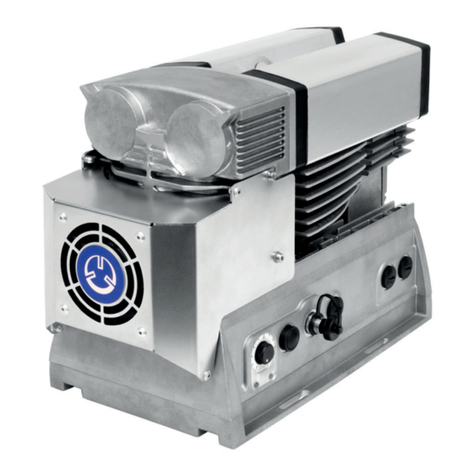
Becker
Becker VariAir VASF 2.50/1-0.AC230 operating instructions

Lifeguard Aquatics
Lifeguard Aquatics Sea Horse Installation and user guide

Oerlikon Leybold Vacuum
Oerlikon Leybold Vacuum Sogevac SV630 B operating instructions

Grundfos
Grundfos DMX 226 instructions

Graco
Graco Dyna-Star HP 77X202 instructions
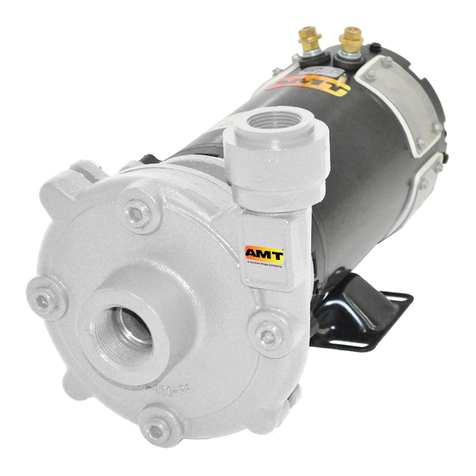
GORMAN-RUPP
GORMAN-RUPP AMT 12DC-95 Specifications information and repair parts manual
